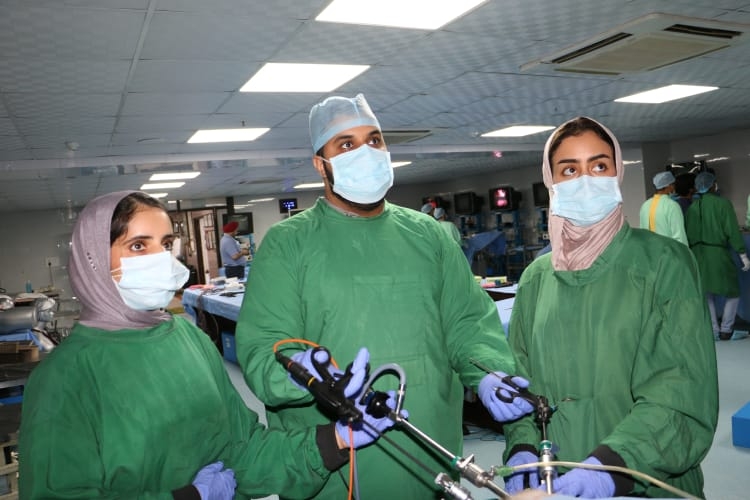Event Date: Fri - 20 Sep, 2024
Event Time: 9:10 am
Location: World Laparoscopy Hospital
Institute: WLH
Laparoscopic Burch colposuspension is a negligibly obtrusive careful strategy planned explicitly for treating pressure urinary incontinence in ladies. This method works by offering help to the urethra and bladder neck, really decreasing compulsory spillage of pee during proactive tasks like hacking, sniffling, or work out. Another significant surgical procedure, sacrohysteropexy involves securing the uterus to the sacral promontory in order to treat uterine prolapse, in which the uterus enters the vaginal canal. This obsession not just reestablishes the typical physical place of the uterus yet additionally mitigates related side effects and works on the general personal satisfaction for patients. Pectopexy is a specific careful methodology pointed toward revising vaginal vault prolapse, which might happen after a hysterectomy. This strategy includes connecting the vaginal zenith to the pelvic sidewall, consequently building up the help designs of the pelvic organs. Nissen fundoplication is a deep rooted careful strategy for overseeing gastroesophageal reflux illness (GERD). In this method, the upper piece of the stomach is folded over the lower some portion of the throat, making a boundary that keeps stomach corrosive from streaming once more into the throat, subsequently mitigating side effects like acid reflux and disgorging. Rectopexy is utilized to treat rectal prolapse, a condition described by the rectum projecting through the butt. This careful method includes tying down the rectum to the sacrum, accordingly reestablishing its legitimate position and capability, and altogether further developing the patient's personal satisfaction. Heller myotomy is explicitly intended to address achalasia, a problem that influences the throat's capacity to push food toward the stomach. This procedure eases the distressing symptoms of this condition and makes food easier to pass through by surgically cutting the muscles at the lower end of the esophagus. Nephrectomy includes the careful expulsion of a kidney and might be performed in light of multiple factors, including kidney sickness, cancers, or giver organ obtainment. This strategy is urgent in overseeing conditions that compromise kidney capability and in general wellbeing.
World Laparoscopy Hospital: A Hub of Contemporary Learning with Daily 8-Hour Hands-On Laparoscopic Training
In the realm of medical education and training, there are institutions that stand out as pioneers, constantly pushing the boundaries of what is possible. One such institution is the World Laparoscopy Hospital, where a contemporary event unfolds every day, featuring a remarkable 8-hour hands-on laparoscopic training program.
A Daily Revolution in Learning
At the heart of the World Laparoscopy Hospital's mission is the commitment to train the next generation of surgeons and medical professionals in the art and science of Minimal Access Surgery. What makes this institution truly exceptional is its daily 8-hour hands-on laparoscopic training program.
The Laparoscopic Revolution
Laparoscopic surgery, often referred to as minimally invasive surgery, has revolutionized the field of surgery in recent decades. Instead of large incisions, this technique involves making tiny keyhole-like openings through which a camera and surgical instruments are inserted. This results in significantly reduced patient trauma, shorter recovery times, and less post-operative pain.
The Daily Experience at World Laparoscopy Hospital
Every day at World Laparoscopy Hospital is a contemporary event in the world of medical education. Here's a glimpse into what a typical day looks like for those fortunate enough to train at this prestigious institution:
1. Intensive Training: The 8-hour hands-on laparoscopic training is an immersive experience where trainees work side by side with experienced surgeons. This hands-on approach ensures that students gain practical skills and confidence in performing laparoscopic procedures.
2. State-of-the-Art Facilities: The hospital boasts state-of-the-art facilities, equipped with the latest laparoscopic instruments and technology. Trainees have access to the same tools and equipment used in modern surgical practices around the world.
3. Expert Faculty: The training is conducted under the guidance of expert faculty members who are pioneers in the field of Minimal Access Surgery. Their wealth of knowledge and experience provides students with invaluable insights and mentorship.
4. Customized Curriculum: The training program is tailored to the specific needs and experience levels of each student. Whether you are a novice or an experienced surgeon looking to refine your skills, there is a program to suit your requirements.
5. Global Reach: World Laparoscopy Hospital attracts medical professionals from all corners of the world. This diverse group of trainees fosters cross-cultural exchanges and collaborations, enriching the learning experience.
6. Research Opportunities: Beyond the hands-on training, the hospital also serves as a hub for research and innovation in the field of Minimal Access Surgery. Trainees have the opportunity to participate in cutting-edge research projects.
Impact Beyond the Classroom
The impact of the daily 8-hour hands-on laparoscopic training at World Laparoscopy Hospital extends far beyond the classroom. Graduates of this program return to their respective countries armed with advanced skills, contributing to the global dissemination of minimally invasive surgical techniques. Patients around the world benefit from the reduced invasiveness, faster recoveries, and improved outcomes that these skilled professionals bring to their practice.
In conclusion, World Laparoscopy Hospital's commitment to daily 8-hour hands-on laparoscopic training is a testament to its dedication to excellence in medical education. By offering a world-class learning environment and fostering a culture of innovation, this institution is shaping the future of surgery, one trainee at a time. It is not just an institution; it is a beacon of hope for patients and a driving force in advancing the field of surgery.


